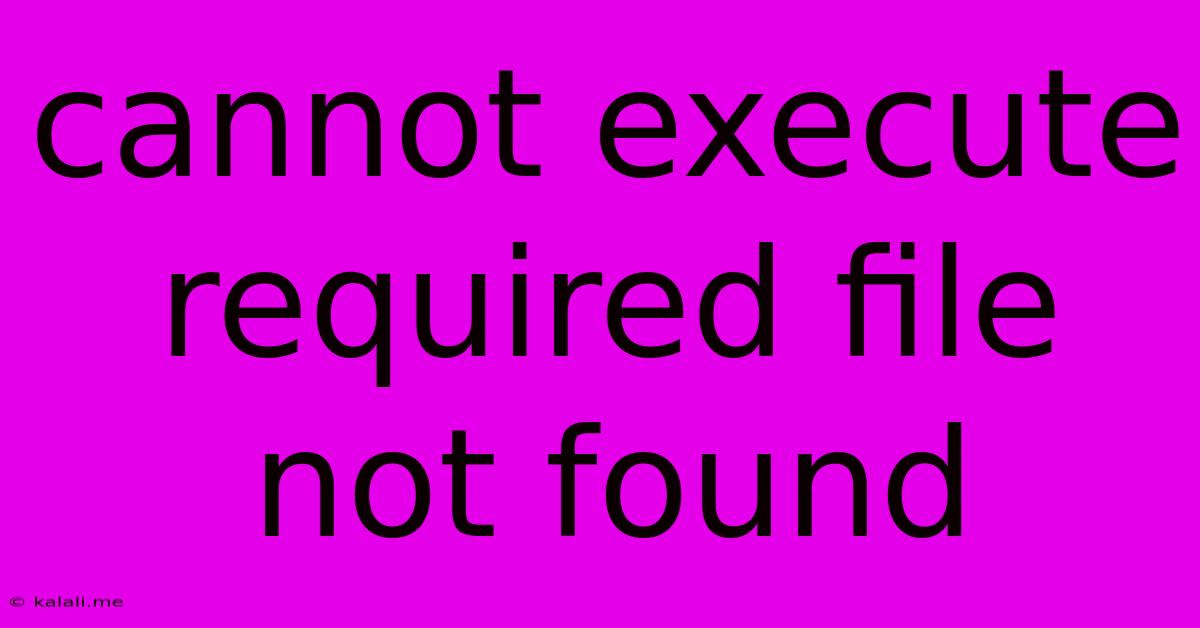Cannot Execute Required File Not Found
Kalali
May 23, 2025 · 4 min read

Table of Contents
The "Cannot Execute Required File Not Found" Error: Troubleshooting and Solutions
The dreaded "Cannot execute required file not found" error can strike at any time, halting your program or script in its tracks. This frustrating message usually indicates a problem locating a crucial file your application needs to run. This article will delve into the common causes of this error and provide practical troubleshooting steps to help you resolve it. Understanding the underlying issues will save you valuable time and frustration.
Understanding the Error:
This error message isn't specific to a single programming language or operating system. It's a general indicator that your software can't find a necessary file to execute its commands. The missing file could be an executable, a library, a configuration file, or even a data file depending on the application. The key is to identify which file is missing and why.
Common Causes and Troubleshooting Steps:
Here's a breakdown of the most frequent reasons behind this error, along with solutions:
1. Incorrect File Path:
- Problem: The most common cause is an incorrect or incomplete file path specified in your program's code or configuration files. Typos, outdated paths after file relocation, or incorrect directory structures can lead to this issue.
- Solution:
- Double-check your code: Carefully review all file paths within your code or scripts. Ensure they are accurate, including capitalization and the correct directory separators (forward slash
/or backslash\depending on your OS). - Verify file existence: Use your operating system's file explorer to confirm the file exists in the specified location.
- Print file paths: In your code, add print statements to display the file paths being used. This can help pinpoint discrepancies.
- Use absolute paths: Consider using absolute paths (paths starting from the root directory) instead of relative paths to avoid ambiguity.
- Double-check your code: Carefully review all file paths within your code or scripts. Ensure they are accurate, including capitalization and the correct directory separators (forward slash
2. Missing Files or Dependencies:
- Problem: The required file might genuinely be missing. This is common after software installation issues, accidental deletions, or incomplete downloads. The program may also depend on external libraries or modules that are not installed.
- Solution:
- Reinstall the software: If the problem arose after installation, try reinstalling the application. Ensure you have administrator privileges during installation.
- Check for missing dependencies: If your program relies on external libraries (DLLs on Windows, shared objects on Linux/macOS), verify they're installed correctly. Use your system's package manager (e.g., apt, yum, Homebrew) to install any missing dependencies.
- Recover deleted files: If you accidentally deleted the file, try recovering it from the recycle bin (Windows) or trash (macOS). Data recovery software might be necessary for more complex scenarios.
3. Permissions Issues:
- Problem: Your program might lack the necessary permissions to access the file, even if the file exists. This is especially relevant when dealing with system files or files located in restricted directories.
- Solution:
- Run as administrator: Try running your program as administrator (right-click and select "Run as administrator" on Windows).
- Check file permissions: Use your operating system's tools to verify the file permissions. Ensure your user account has read and execute permissions for the file. Adjust permissions if necessary (this requires administrative privileges).
4. Corrupted Files:
- Problem: The required file might be corrupted. This can happen due to incomplete downloads, software bugs, or hard drive errors.
- Solution:
- Re-download or reinstall: If the file was downloaded, try downloading it again from a trusted source. Reinstallation of the software is often a good solution as well.
- Verify file integrity: Some software packages offer checksum verification tools to confirm the file's integrity.
5. Environment Variable Issues (for scripts and programs):
- Problem: The application may rely on environment variables to locate necessary files. If these variables are not set correctly, the error will occur.
- Solution:
- Check environment variables: Verify the environment variables related to the application are correctly configured. Use your operating system's settings or command-line tools to inspect and modify them (e.g.,
echo %PATH%on Windows,echo $PATHon Linux/macOS).
- Check environment variables: Verify the environment variables related to the application are correctly configured. Use your operating system's settings or command-line tools to inspect and modify them (e.g.,
By systematically investigating these potential causes and applying the troubleshooting steps, you'll significantly increase your chances of resolving the "Cannot execute required file not found" error and get your application running smoothly again. Remember to always back up important data before making significant changes to your system or software.
Latest Posts
Latest Posts
-
How Many Apples In 3 Lb Bag
Jul 05, 2025
-
What Is Half A Quarter Of 400
Jul 05, 2025
-
How Do You Make A Vegetable Necklace
Jul 05, 2025
-
How Many 750ml Are In 1 75 Liters
Jul 05, 2025
-
How Many Grams Is In Half An Ounce
Jul 05, 2025
Related Post
Thank you for visiting our website which covers about Cannot Execute Required File Not Found . We hope the information provided has been useful to you. Feel free to contact us if you have any questions or need further assistance. See you next time and don't miss to bookmark.